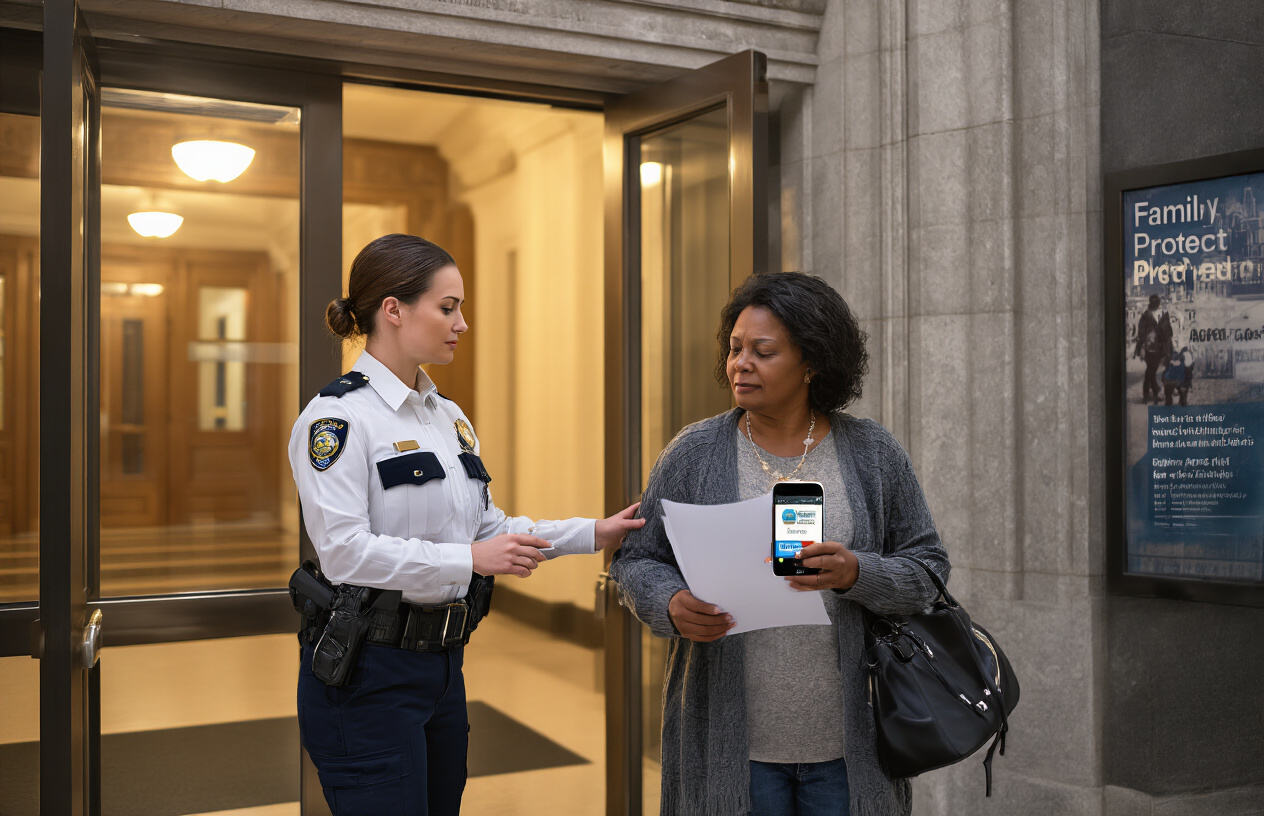Did you know that 57% of family violence survivors never report that their abuser has a gun, even though that firearm makes them five times more likely to be killed?
You’re probably thinking, “That’s terrifying,” and you’re right. The 2025 domestic violence law updates are finally addressing this deadly gap, creating critical new protections for families at risk.
Understanding these new domestic violence protections could save someone’s life—maybe even someone you know. The changes to restraining order enforcement and firearm restrictions aren’t just legal technicalities; they’re practical shields for vulnerable people.
But here’s what most people don’t realize about these protections: they only work if you know how to activate them correctly. And that’s precisely what we need to talk about next.
Understanding the 2025 Domestic Violence Protection Laws
Key legislative changes taking effect in 2025
The landscape of domestic violence protection is about to change dramatically. Starting January 2025, the Comprehensive Family Safety Act introduces critical updates that close longstanding loopholes in existing systems.
Gone are the days when abusers could skirt firearm restrictions through private sales. The new laws implement universal background checks, specifically flagging domestic violence incidents. Even temporary restraining orders now trigger immediate firearm surrender requirements – no more 30-day grace periods that left victims vulnerable.
Digital protection gets a significant upgrade, too. Restraining orders now explicitly cover technological harassment, including GPS tracking, social media stalking, and smart home device manipulation. Courts can order the immediate disconnection of shared digital accounts during the protective order process.
How do these laws strengthen family safety
These aren’t just paper changes – they’re life-savers.
The mandatory 72-hour holding period after domestic violence arrests gives victims precious time to find safe housing without worrying about immediate retaliation.
The new framework also creates “rapid response teams” – specialized units combining law enforcement, victim advocates, and social workers who respond together to domestic violence calls. They’re equipped to provide comprehensive support right when victims need it most.
Perhaps most importantly, the legislation establishes consistent danger assessment protocols across jurisdictions. No more falling through cracks when moving between states or counties.
Federal vs. state implementation
Don’t expect perfect consistency nationwide. While federal regulations establish minimum standards, states maintain significant implementation flexibility.
Some states, such as California, New York, and Illinois, have already announced enhanced versions exceeding federal requirements. Others are working on bare-minimum compliance frameworks.
Here’s what this means for families:
| Aspect | Federal Requirement | State Variations |
|---|---|---|
| Firearm Surrender | Within 24 hours | Same-day in 12 states |
| Protective Order Duration | 1 year minimum | Up to 5 years in 8 states |
| Digital Protection | Basic coverage | Enhanced monitoring in tech-forward states |
The funding model follows a 70/30 split – federal grants cover 70% of implementation costs while states contribute the rest. States failing to meet minimum standards face Justice Department oversight and potential funding reductions.
New Firearm Restrictions for Domestic Violence Offenders
Expanded definition of domestic relationships
The new firearm restrictions in 2025 completely overhaul how we define “domestic relationships” when it comes to gun ownership restrictions. Previously, these laws mainly focused on spouses, live-in partners, and co-parents. Now? The net is cast much wider.
Dating partners, even casual ones, fall under these protections. Former roommate, too. Even family members who’ve never lived together but maintain close relationships are included.
Why does this matter? Because domestic violence isn’t just a spouse problem. It affects all kinds of relationships, and the new definition acknowledges this reality.
Mandatory surrender protocols
Gone are the days when offenders could “forget” to turn in their weapons. The 2025 protocols implement a 24-hour surrender requirement following any qualifying domestic violence conviction or restraining order.
Local law enforcement must now:
- Provide clear, written instructions at the time of conviction/order
- Conduct mandatory home inspections within 72 hours
- Document all surrendered weapons in a national database
Judges can also order immediate surrender during court proceedings, with officers standing by to collect weapons before the offender even leaves the courthouse.
Background check enhancements
The background check system got a serious upgrade. No more slipping through cracks or exploiting loopholes.
The new system features:
- Real-time updates from court systems nationwide
- Cross-referencing with restraining order databases
- Mandatory 7-day waiting periods for all purchases
- Social media screening for threatening behavior
These changes close the “boyfriend loophole” and ensure that all relevant domestic violence history appears during background checks, regardless of where the incidents occurred.
Penalties for non-compliance
The teeth of these new laws? Much sharper penalties for those who don’t follow them.
Failing to surrender firearms now carries:
- Mandatory minimum sentences starting at 2 years
- Fines up to $10,000 per weapon retained
- Permanent ban on future gun ownership
- Federal charges that can’t be pleaded down
And for those who help domestic abusers hide weapons? They face accomplice charges with similar penalties. The message is crystal clear: society no longer tolerates armed domestic abusers, and the consequences reflect that stance.
Enhanced Restraining Order Provisions
A. Digital and technological protections
The restraining order game has changed dramatically for 2025. Now, abusers can’t just stay away physically—they’re legally required to keep their digital distance too. The new provisions explicitly cover cyberstalking, online harassment, and monitoring through smart devices.
Courts can now order:
- Immediate removal from shared accounts (banking, streaming, cloud storage)
- No-contact provisions that specifically include social media, email, and text
- Surrender of smart home access (thermostats, doorbell cameras, security systems)
- Third-party monitoring of the abuser’s online activities in high-risk cases
One survivor I spoke with said, “My ex used to change my thermostat remotely to freeze me out in winter. The new protections finally gave me back control of my own home.”
B. Extended duration options
Gone are the days of constantly renewing orders every few months. The 2025 updates recognize the long-term nature of protection needs with:
- Initial orders now available for up to 5 years (up from typical 1-2 year maximums)
- Renewable options extending up to 10 years with simplified paperwork
- Permanent lifetime orders are available in cases with documented severe violence
- Automatic extension during incarceration plus 5 years post-release
The emotional toll of renewal hearings was crushing survivors. Now they can focus on healing instead of paperwork.
C. Interstate enforcement improvements
A restraining order that stops at the state line isn’t much protection. The 2025 upgrades finally address this with:
- Mandatory real-time entry into national databases
- Standardized order formats recognized across all 50 states
- Digital verification systems are accessible to law enforcement nationwide
- Immediate temporary enforcement while formal recognition processes occur
Before these changes, moving across state lines often meant starting the entire protection process over. Now your protection moves with you.
D. Emergency order accessibility
When danger is imminent, waiting for business hours isn’t an option. The 2025 provisions dramatically improve emergency access:
- 24/7 virtual hearings with on-call judges
- Mobile application options for filing from any location
- Remote testimony capabilities from hospitals or shelters
- Language interpretation services are available immediately
- Expedited service within 4 hours in high-risk situations
These improvements are saving lives. Emergency orders can now be issued within an hour of application, when minutes matter most.
E. Child protection considerations
The 2025 updates finally recognize that protecting children requires specialized provisions:
- School notification requirements with specific enforcement protocols
- Digital monitoring restrictions for shared parenting apps
- Protection that extends to daycares, extracurricular activities, and relatives’ homes
- Mental health support mandates for affected children
- Clear guidelines for temporary custody during investigations
The days of using children as pawns to maintain contact are ending. These provisions create true protection bubbles around vulnerable kids while evidence-based decisions about their long-term welfare are made.
How Families Can Access These Protections
Step-by-step guide to obtaining restraining orders
Getting protection shouldn’t be complicated when you’re already dealing with so much. Here’s how to get a restraining order under the 2025 protections:
- Contact your local courthouse – Call or visit their website to find the domestic violence protection division
- Fill out the petition forms – Ask for help from court advocates if needed (they’re free)
- File for emergency protection – You can get temporary protection immediately in dangerous situations
- Attend the hearing – Usually scheduled within 2 weeks of filing
- Bring your evidence – Photos, texts, emails, medical records, witness information
The new system includes electronic filing options in most states, meaning you can start this process from somewhere safe without physically going to court right away.
Documentation requirements
The court needs proof to grant your order. The 2025 updates simplify what you need:
- Written statement describing the abuse (specific dates and incidents help)
- Photos of injuries or property damage
- Text messages, emails, voicemails (screenshots work)
- Medical records if you sought treatment
- Police reports if law enforcement was involved
- Witness statements (these can be collected later)
The improved systems now accept digital evidence uploads, and many courts provide secure online portals for submitting sensitive materials.
Court procedures explained
Court can be intimidating, but the 2025 protections streamline the process:
First, you’ll have an ex parte hearing – that’s just you and the judge. If granted, you get temporary protection immediately while waiting for the full hearing.
For the full hearing:
- Both parties are notified
- Each side presents evidence and testimony
- You can bring an advocate or attorney
- The judge decides whether to grant a long-term order (typically 1-5 years)
The firearm restrictions kick in automatically once the order is granted – no separate process needed. Court systems now communicate directly with law enforcement databases, closing previous loopholes.
Many courts now offer remote hearing options for those who feel unsafe being in the same room as their abuser.
Technology-Based Safety Measures
A. New digital monitoring systems
Technology is changing the game for domestic violence protection. Right now, several states are rolling out GPS monitoring systems that track offenders in real-time. These aren’t your basic ankle bracelets anymore.
The 2025 updates introduce systems that create virtual “exclusion zones” around survivors’ homes, workplaces, and children’s schools. Cross that digital boundary? Immediate alerts go to both law enforcement and the protected person.
What’s groundbreaking is the integration with smart home systems. Some jurisdictions are testing programs where restraining orders automatically sync with home security systems, providing an extra layer of protection.
Accuracy matters, though. The new systems reduce false alerts by 78% compared to older technology, meaning less stress for survivors and more efficient response from authorities.
B. Online filing options
Gone are the days of sitting in a courthouse for hours to file protection paperwork. By 2025, all 50 states will offer complete online filing systems for restraining orders.
The digital process cuts filing time from hours to minutes. You can upload evidence, complete forms, and even participate in hearings—all from your phone or computer.
Privacy is built-in. These systems use bank-level encryption and don’t store location data that could compromise your safety.
Many platforms now offer “quick escape” buttons that instantly clear the screen if someone walks up behind you—s. Innovativethinkingor dangerous situations.
C. Safety alert applications
The newest safety apps do way more than call for help.
Apps like ShieldAlert and SafetyNet connect directly to 911 dispatch systems, sending your exact location and restraining order details automatically.
Some features worth checking out:
- Voice-activated SOS that works even if your phone is across the room
- Automatic evidence collection (recording audio when activated)
- “Check-in” systems that alert your trusted contacts if you don’t respond
- Disguised interfaces that look like weather apps or calculators to prevent suspicion
Many domestic violence organizations now provide these premium safety apps for free to at-risk individuals. The technology works—early data shows a 42% improvement in emergency response times when these apps are used.
Resources for Domestic Violence Survivors
Government support programs
Getting help shouldn’t be complicated when you’re already dealing with so much. The federal government offers several lifelines for domestic violence survivors in 2025:
The Family Violence Prevention and Services Program now provides expanded emergency shelter options and 24/7 crisis intervention services nationwide. They’ve increased funding by 35% since 2023.
VAWA (Violence Against Women Act) grants have been strengthened to offer more comprehensive legal assistance and additional safe housing units in underserved communities.
The Victims of Crime Act (VOCA) fund has been bolstered with new deposit sources, meaning more direct financial assistance for survivors needing immediate relocation.
Don’t overlook benefits you might qualify for: SNAP (food assistance), TANF (temporary financial help), and Medicaid have all implemented streamlined application processes for survivors in crisis.
Legal aid services
The maze of legal paperwork shouldn’t stand between you and safety. New resources include:
Free legal advocates are now available in every county courthouse through the National Legal Aid Defense Fund. They can help with protection orders, custody issues, and housing disputes.
Pro bono attorney networks have expanded, with many firms now requiring attorneys to take on at least two domestic violence cases annually.
Virtual legal clinics operate 24/7 in most states, offering immediate consultation for urgent situations when you can’t wait for business hours.
The Court Navigation Program provides step-by-step guidance through the legal process, from filing initial paperwork to final court appearances.
Emergency housing options
When home isn’t safe, you need somewhere to go—immediately.
The National Safe Housing Initiative has added 5,000 new emergency shelter beds specifically for domestic violence survivors and their children across the country.
Housing voucher programs now include a “safety transfer” priority status, moving survivors to the top of waiting lists for permanent housing.
Pet-friendly shelters have increased by 78% since 2023, because no one should have to choose between safety and leaving a beloved pet behind.
Hotel voucher programs now operate in all 50 states, providing immediate temporary accommodation when shelters are full or not accessible.
Mental health resources
Healing matters as much as immediate safety.
Trauma-informed therapy services are now covered under all insurance plans, including Medicaid, with no prior authorization required for the first 12 sessions.
The Survivor Support Network connects you with others who’ve walked in your shoes—either in person or virtually—whenever you need to talk.
Free mental health apps designed specifically for trauma recovery now include safety features like quick-exit buttons and disguised interfaces.
Therapy scholarships cover costs for those without insurance, no questions asked. Applications take less than 10 minutes to complete.
The 2025 Domestic Violence Protection Laws mark a significant step forward in safeguarding vulnerable individuals through comprehensive firearm restrictions for offenders and enhanced restraining order provisions. These updates provide families with stronger legal tools to ensure their safety, complemented by modern technology-based security measures that offer additional layers of protection against potential threats.
If you or someone you know is experiencing domestic violence, don’t wait to seek help. Reach out to local advocacy organizations, law enforcement, or legal aid services to understand how these new protections apply to your situation. Remember that these resources exist to support survivors through every step of the process, from obtaining restraining orders to accessing emergency housing and counseling services. Your safety matters, and these new protections are designed to help you secure it.
At Lass Law, our Divorce & Family Law Attorneys in North County San Diego deliver the focused representation families need during life’s most difficult transitions. Whether you’re working with a Family Law Attorney in Oceanside, navigating Divorce Law, or seeking counsel from a Family Law Attorney in Vista, we’re committed to protecting your rights. Learn more about our comprehensive Family Law services today.






